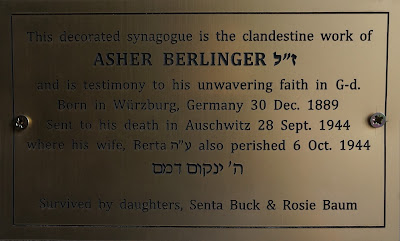 |
| Terezin, CZ. "Secret Synagogue". "May your eyes behold Your return to Zion in compassion" (Amidah). Photo: Samuel Gruber 2018. |
 |
| Terezin, CZ. "Secret Synagogue". Painted candles flanking the location of the Ark. Photo: Samuel Gruber 2018 |
 |
| Terezin, CZ. "Secret Synagogue". Photo: Samuel Gruber 2018 |
by Samuel D. Gruber
A few weeks ago I visited Terezin, the 18th-century military city in northern Bohemia (now Czech Republic) that was remade beginning in 1941 into Germany's "model ghetto" they called Theresienstadt - a vast overcrowded holding pen for discouraged, uncertain, underfed, and exploited Jewish prisoners from Germany, Austria, Czechoslovakia, Holland, Belgium, and other countries which "housed" as many as 58,000 men, women and children held there at one time - always with the overflow population being sent off to death at Auschwitz, and then most of the inmates sent there, too. While Terezin was re-concerted into a town after World War II, today parts are now maintained as the Terezin Memorial.
Terezin was the ante-chamber to Auschwitz for more than a hundred thousand Jews. There are many aspects to the historical town and to the Nazi-created ghetto about which I could write - architectural, urban, interpretive, preservationist, museological, anthropological, etc. Here I only discuss the so-called "secret synagogues," those places where Jews gathered with tacit German permission to pray and follow age-old religious rituals under new and horrific circumstances. Most of the prayer places were used on as an "as needed" basis by adapting other spaces. This is documented in many surviving drawings and in some survivor accounts.
 |
| Helga Weissova Hoskova (b. 1929) Hanukah in the attic of block L410, 1943. Helga was 14 years old when she made this drawing. Source: Artists of Terezin. |
This fall I'll be teaching a class at Syracuse University on "The Holocaust, Memory and the Visual Arts," so this prayer room has immediate relevancy for me.There are very few places where art made by Holocaust victims remains intact and in situ, and where the intent can be so clearly understood. We have many surviving artworks - mostly small sketches - made by various artist prisoners of some of the impromptu prayer spaces in the Ghetto, but this is the only such space that survives at all intact. At least one other decorated prayer space is known from a drawing made by Paul Schwarz, who depicts painted lions holding the Tablets of the Law on the Ark wall (Schwarz was subsequently killed at Auschwitz, but his wife survived and saved many of his drawings).
 |
| Terezin, Czech Republic. Prayer room in former garage. Drawing by Paul Schwartz. Source: L. Chladkova, The Terezin Ghetto. |
Lastly, I was proud to visit because the second restoration of the Berlanger synagogue after the devastating floods of 2002 was carried out with financial assistance of the U.S. Commission for the Preservation of America's Heritage Abroad, of which I was Research Director at the time. I had nothing directly to do with the project, but it was a very good one for the Commission to support (raising private funds). Commission member Amy Epstein led the Commission funding effort and Seth Gerszberg made the major donation to the project. Besides the inevitable emotion on entering this little space, after many years I was very excited to see the result of their work.
 |
| Terezin, CZ. "Secret Synagogue". Small plaque over entrance to synagogue acknowledging donors to restoration. Photo: Samuel Gruber 2018. |
 |
| Terezin, Czech Republic, Small plaque giving information about Artur Berlinger, who created and presided over this worship space. Photo: Samuel D. Gruber 2018. |
 |
| A calendar for the Jewish Year 5704 (1943-44) that was illustrated by Asher Berlinger in Terezin. Photo: Yad Vashem, |
 |
| A calendar for the Jewish Year 5704 (1943-44) that was illustrated by Asher Berlinger in Terezin. Photo: Yad Vashem, |
 |
| Terezin, CZ. "Secret Synagogue." "Know before whom you "stand" is probably the most common passage found in synagogues, and it was used here on the side wall which is where the "ark" - or whatever was used in its place - would have stood. The niche in the wall is flanked by paintings of candles. Photo: Samuel Gruber 2018. |
 |
| Terezin, CZ. "Secret Synagogue". "If I forget you, O Jerusalem, let my right hand forget its skill," (Psalms 137:5). Photo: Samuel Gruber 2018 |
Unfortunately for the visitor, the multi-lingual translation of these texts are only available in an accompanying book, and not in the prayer hall or immediately adjacent, so that most visitors lose this important aspect of the experience.
This space was rediscovered in 1989 and restored in the 1990s, but then seriously damaged in the floods of 2002, before being restored again. Parts of the inscriptions were irrevocably destroyed and are now documented only in photos.
 |
| Terezin, CZ. "Secret Synagogue".Courtyard from where the synagogue is entered (door on right) Photo: Samuel Gruber 2018. |
 |
| Terezin, CZ. "Secret Synagogue". Entryway from courtyard to synagogue. Photo: Samuel Gruber 2018. |
 |
| Bedrich Fritta. Jews at prayer. |
 |
| Leo Haas. Religious Services, Terezin. Source: Art of the Holocaust, fig 750. |
 |
| Leo Haas. Religious Services. Artists of Terezin. |
 |
| Moritz Nagel, Prayer, Terezin, 1943. |
 |
| Jan Burka (b. 1924, Prague). Prayers in the attic, Terezin. Pencil. Source: Yad Vashem. |
 |
| Ferdinand Bloch. Terezin Services in the Attic. Source: Jewish Customs and Traditions Jewish Museum of Prague), 34. |







No comments:
Post a Comment